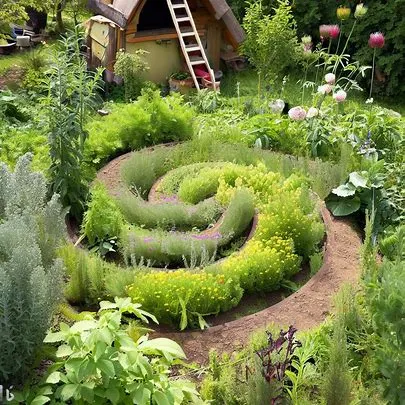Embracing Herb Spirals in Permaculture: A Harmonious Blend of Functionality and Beauty
In the realm of permaculture design, one key principle reigns supreme: maximizing efficiency and synergy between various elements of the ecosystem. Herb spirals epitomize this philosophy, offering a dynamic and space-saving solution to integrate diverse herbs into the garden landscape. In this blog post, we will explore the reasons why incorporating herb spirals into your garden design can elevate your permaculture efforts to new heights. Additionally, we will delve into the step-by-step process of building your herb spiral and choosing the right plants for this thriving microcosm.

1. Understanding the Magic of Herb Spirals
At its core, a herb spiral is a carefully constructed, raised garden bed that is shaped like a spiral, rising gently to form a small hill. The design mimics the natural growth patterns of plants, capitalizing on vertical space to accommodate a wide range of herbs in one compact area. Here's why herb spirals are highly regarded in permaculture circles:
- Enhanced Microclimates: Herb spirals create multiple microclimates within a small footprint. The highest point receives more sunlight and heat, replicating the warm and dry conditions favoured by Mediterranean herbs like rosemary and thyme. As the spiral descends, it offers cooler and more shaded areas for moisture-loving herbs like mint and parsley.
- Water Efficiency: The spiral's unique design allows water to trickle down from the top to the base, ensuring that every plant receives its required share of hydration. This efficient water distribution reduces wastage and supports the growth of plants with varying water needs.
- Increased Biodiversity: By accommodating a wide array of herbs in one structure, herb spirals encourage biodiversity and create a natural defence against pests and diseases. Beneficial insects are drawn to the diverse array of plants, fostering a balanced ecosystem.
2. Building Your Herb Spiral
Constructing a herb spiral requires careful planning and attention to detail. Here's a step-by-step guide to building your own:
- Selecting a Location: Choose a sunny spot in your garden that receives ample sunlight throughout the day. The location should be easily accessible for harvesting and maintenance. Typically a zone 1 element and the closer to your kitchen door the better.
- Gathering Materials: Gather materials like rocks, bricks, stones, and organic matter such as compost and soil. These will form the basic structure of your herb spiral.
- Creating the Spiral: Start by marking the centre of the spiral and gradually build the structure outward. Arrange the rocks or bricks in a spiral pattern, ensuring the walls are sturdy and well-supported. Spirals should be approximately 2m in width and 1 metre in height at the centre.
- Filling the Beds: Fill each bed with a mixture of compost and soil, making sure the topmost bed is the lightest and gradually increasing the organic content as you move downwards.
- Adding Pathways: Create small pathways between the spiral and other features for easy access and maintenance. You can use wood chips or gravel to line these pathways.
3. Selecting the Right Plants
Choosing the right herbs is vital to the success of your herb spiral. Consider the following factors when selecting plants:
- Sunlight Requirements: Place sun-loving herbs like basil, oregano, and thyme on the topmost, sunnier section of the spiral. Partial shade herbs like cilantro and chives can find their spot in the middle levels.
- Complementary Planting: Keep in mind companion planting principles to maximize the benefits of each herb. For instance, planting dill near tomatoes can help deter pests.
- Consider Growth Patterns: Be mindful of the growth habits of herbs. Taller herbs should be placed on the inner side of the spiral, while sprawling ones can spill over the edges.
- Perennial vs. Annual: Choose a mix of perennial and annual herbs to ensure a continuous harvest throughout the year.
In conclusion, herb spirals epitomize the essence of permaculture by offering a holistic approach to garden design. By incorporating these dynamic structures and carefully selecting a diverse range of herbs, you can create a thriving, sustainable, and visually stunning garden that not only benefits you but also the entire ecosystem.
So, let's embrace the beauty and functionality of herb spirals and embark on a journey towards a harmonious and bountiful garden! Happy gardening!


